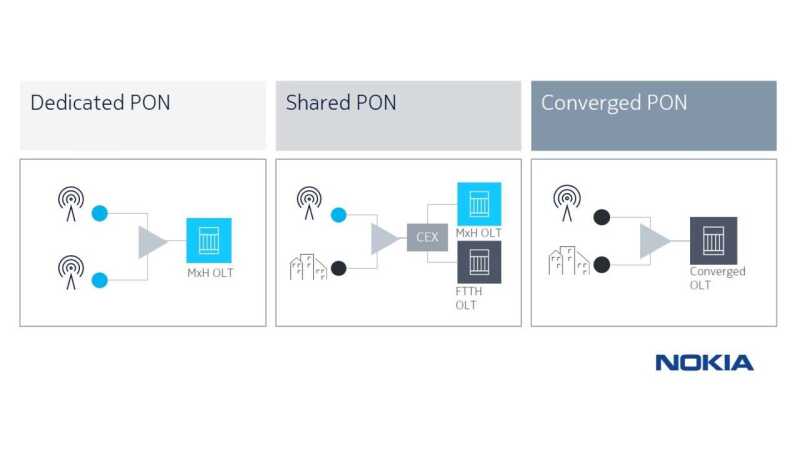Watching movies or playing VR games while being driven in an automated vehicle on a highway with massive numbers of sensors making traffic flow safely and smoothly: that’s a picture of 5G perfection.
So why aren’t we living in this world yet? Well, it of course takes time to deploy any new technology. But 5G needs a rethink in network architecture that brings additional cost and complexity in mobile transport compared to previous generations of mobile technology.
With 3G and 4G, mobile transport is relatively straightforward. Each cell site gets a dedicated point-to-point connection (fibre or microwave) to the core network. There are three key differences with 5G.
First is that the transport network needs to support much higher capacity and, crucially, lower latency.
Second, 5G will need many more cells in many new locations to deliver the performance it promises, each needing a connection.
Third is that 5G is evolving to a disaggregated cloud architecture with some functionality removed from the cell site and hosted either centrally or in distributed locations in the cloud.
New RAN architecture
This means there are now three types of mobile transport (collectively known as “anyhaul”): backhaul between the core and the centralized unit; midhaul between centralized and distributed units; and fronthaul between distributed and radio units (cells). Each has different technical requirements. Backhaul is fairly relaxed about capacity and latency, but fronthaul is the reverse. In fronthaul, the signal is no longer processed at the cell-site, so the unprocessed signal needs to be transported, which can require very high capacity and low latency.
Mobile transport is a big contributor to CAPEX and OPEX—even more so with 5G’s architecture—so having an efficient transport network is a cornerstone of a successful 5G deployment.
A solution that is getting traction is to use PON-based networks for 5G anyhaul. PON, a point-to-multipoint technology, is widely used to connect homes and businesses with Gigabit and multi-Gigabit speeds. It’s already been used, sparingly, for 4G backhaul, but the economics of 5G anyhaul make PON a very attractive proposition.
PON fibre-to-the-home/premises networks already exist in the urban and suburban areas where 5G demand is greatest. Compared to creating a dedicated transport network, plugging 5G cells in to an existing PON can bring down the transport cost by 50% or more. Fibre has enormous capacity so PON can easily absorb new 5G cell sites and the throughput they crave, and still scale with mobile network growth. PON is also designed for massive deployments with simple plug and play addition of network nodes, automated provisioning and fast service turn up. That makes it quick, easy and cost-effective to connect 5G cells.
Matching 5G performance
A little thought is needed to ensure PON meets the stringent transport requirements of 5G. Currently, the most widely deployed PON technology is GPON with 2.5 Gb/s capacity. This is sufficient to support 4G alongside residential broadband, but probably not enough for 5G. However, XGS-PON with 10G capacity is already being deployed by many operators and looks set to be the dominant PON technology by 2025. That is certainly enough for backhaul and midhaul transport., and probably for some instances of fronthaul. However, in very dense urban areas, operators can consider going to the latest 25G PON technology, with the capacity to deliver 5G anyhaul, residential and business broadband all on the same infrastructure. In fact, this is the direction of travel for the industry: a single, point-to-multipoint fibre network able to converge all services, and connect everything and everybody.
In terms of latency, PON has proven to be sufficient for backhaul and midhaul, even with sensitive AR/VR applications. For fronthaul, recent advances in PON mean it will be able to support low latency applications. This includes new innovative ranging processes, multiple bursts per frame per ONT to reduce the inter-burst delay and the O-RAN defined Cooperative Transport interface. The ongoing standardization work looks likely to see the first deployments from 2022 onwards.
Network sharing
With 5G mobile anyhaul needing different performance characteristics from residential and business broadband, it’s important to consider how those services will co-exist on the same infrastructure.
A simple method is to run separate PON networks and just share common outside plant elements like duct and poles. This option neatly segregates operations at the expense of duplicating active equipment and often means just using spare fibres in the same cables and building a dedicated physical network.
Another common sharing method is to use the same fibres but with different wavelengths for different traffic types. For example, fixed residential traffic could use a GPON wavelength while mobile transport uses an XGS-PON wavelength. Fibre allows multiple wavelengths to be used simultaneously, so GPON, XGS-PON and even 25G PON can all use the same fibre strand and carry their own traffic.
A third method is to have a fully converged fibre infrastructure with all traffic on the same wavelength and use multiplexing and rely on statistical oversubscription of the shared medium. Network slicing can also be used to create virtual slices per service (for example, a slice for residential, a slice for anyhaul, etc.), each with its own quality of service.

For most operators, the first use case of 5G is to enhance capacity and coverage, rather than enable new low-latency applications. In these cases, we’re already seeing operators leverage their existing PON networks to be able to easily connect new 5G cell sites, greatly reducing costs and accelerating time to market. As operators begin deploying mmWave 5G (as opposed to the sub-6 GHz 5G spectrum that is the current default), existing PONs become even more attractive because of the sheer number of 5G cells that will need connecting.
As fibre networks are being widely deployed, there is a big opportunity to leverage them to accelerate 5G deployments and make them more cost efficient. A study by the FTTH Council Europe study claims that where there is FTTH, the incremental cost to make the network 5G-ready are marginal: you virtually get 5G fibre connectivity for free.
Obviously, it makes things easier for fixed or converged operators who have their own PON networks. But even mobile operators can—and should—consider PON for 5G anyhaul. In any case, mobile operators already operate point-to-point fibre connections for 3G and 4G sites. By leasing dark fibre or a virtual slice of another operator’s FTTH network and deploying their own PON access equipment, they would be able to easily connect 5G cells with small form factor pluggable (SFP) optical equipment (typically 12-14 cm) that is directly plugged in the cell site. So, no additional space, nor any additional power is needed.
So, the challenge for rapid 5G deployment is as much economic as it is technical. This sets the stage for a new mobile anyhaul approach for which PON is perfectly suited.





